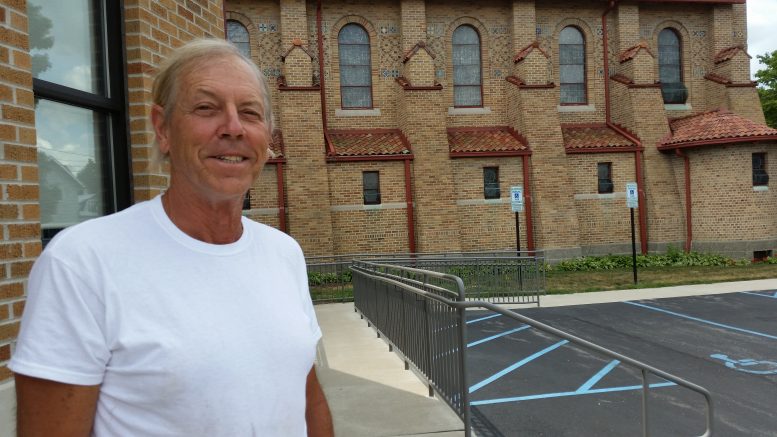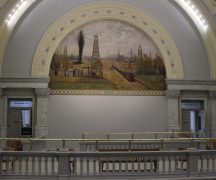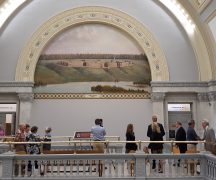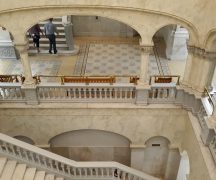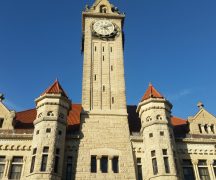By JAN LARON McLAUGHLIN
BG Independent News
Bill Meyers has spent much of his life looking down on Northwest Ohio. As a steeplejack for more than 40 years, he has climbed up clock towers, church steeples, radio towers and nuclear cooling structures.
Originally from Napoleon, Meyers has done much of his work here in Bowling Green – from lighting the courthouse clock to renovating the historic dome at Trinity United Methodist Church.
Just gazing up at tall structures is enough to give some people a twinge of panic. But Meyers is quite comfortable working and walking at great heights.
“I always liked being up in the air,” Meyers said recently as he took a break from working on the bell tower at St. Aloysius Catholic Church in Bowling Green.
As a child he had a treehouse with no ladder or rope. “Nobody could come up unless they could climb.”
By age 15, he was doing freefall skydiving.
“I should have been a bird.”
Meyers was a student at BGSU in the 1970s when he started doing odd jobs for local landlords and government officials. It quickly became known that the young Meyers could handle heights, so his skills were tapped for putting up the first outdoor sirens in the county and helping install water towers in the city.
As if that weren’t enough of a thrill, Meyers also took a side job wiring explosives and detonating them on a blasting job.
Now at age 67, Meyers still free climbs and still appreciates a good challenge.
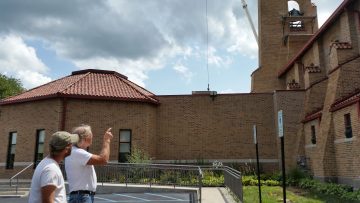
Bill Meyers talks with Andrew Carnahan about steeple.
Phil Whaley, an engineer with Poggemeyer Design Group, has worked on more than 100 jobs with Meyers over the years and considers the steeplejack to have rare skills. “That’s putting it mildly.”
Whaley distinctly remembers Meyers walking the ridge of the towering St. Patrick’s Church near downtown Toledo.
“It was like he was walking down a sidewalk,” Whaley said.
As valuable as his handling of heights is Meyer’s ability to come up with inexpensive solutions to seemingly impossible to solve problems.
“He’s never met a problem he couldn’t figure a way around,” Whaley said. “He’s got quite a creative mind when it comes to solving problems.”
Take for example, the microwave towers installed on top of AT&T silos. Meyers devised some “weird fabrications” to hang the microwave dishes off the side. “Almost everything he does has a weird twist to it,” Whaley said.
Or the University of Toledo tower, where Meyers realized a helicopter was needed to drop steel through a hole in the roof to support scaffolding while repairing the concrete.
Then there are the bridge inspections, where he rigged up a pulley system to carry workers on a platform.
“It’s tough to get underneath these old bridges,” Whaley said.
When a collapse occurred at the Campbell Soup plant, Meyers used cable to make a spider web deck for workers over a glass area.
“He’s an adrenalin junkie. He looks for weirder and weirder things to do,” Whaley said.
Yet, Meyers has a safety record to be envied. When he started climbing for a living, there was no OSHA, no EPA to set safety standards.
“It was just survival on instincts,” Meyers said. “I was doing some dangerous stuff.”
His first business was called Golden Grip Inc. The business now is called W.R. Meyers Co. His favorite jobs have all involved historic structures.
Meyers is a regular fixture anytime work is needed in the clock tower of the Wood County Courthouse. One of his jobs was to redesign the clock hands and light the clock so it could be read at night.
“Because one of the commissioners’ wives said she wanted to read the hands from Kaufman’s parking lot,” Meyers said with a grin. He tried many different combinations of hands and lights before finding one that clicked.
“I like doing that kind of stuff,” he said. “I thought that really gave it some pizazz.”
When Bowling Green revitalized its downtown, Meyers worked to fortify many of the aging structures.
“Everybody from kids to farmers would walk up and want to know what’s next,” he said.
He particularly enjoyed working on the law office at the southwest corner of Main and Wooster streets. “The building was collapsing. Because of the complexity, it was one of my favorites.”
Meyers has worked on the exterior of the city police station, refurbished chimneys at the courthouse, restored windows and railings at the old Milliken Hotel, maintained ODOT radio towers, worked on the football stadium lighting at BGSU, helped take down the smokestack at BGSU, hung new bells in a Custar church, worked on the cooling towers at Davis Besse nuclear power plant, and helped restore the mural façade on the Jerome Library. His business always has a waiting list.
His work takes him to Chicago and Pittsburgh, where his night climbing skills allow him to work on radio and TV transmitter towers.
But above all, Meyers has a soft spot for historic buildings, especially old churches.
“He saves them a lot of money,” Whaley said.
Meyers chalks that up to the “thrifty” German-Dutch in his blood. “I’m always trying to build something from nothing.”
“Phil and I have done a lot of things for free,” he said, mentioning restoration of historic buildings at Lakeside. “It’s always good to give a helping hand.”
Recently, Meyers was hired to check out the inside of the historic St. Anthony’s church in Toledo after efforts were made to save the structure. Meyers wasn’t sure what he would find inside the 100-foot steeple.
“It’s probably the finest steeple I’ve ever been in,” he said. “Those Polish people knew what they were doing.” The roofline is still “straight as an arrow” and from top of the steeple to the ground, the structure is only 1 inch off plumb.
Meyers is cognizant that churches can’t always afford to restore buildings. So he works with them, at their speed.
“For years we put patches on things until people have the money,” he said. It’s “magic” when it finally comes together.
Last week, Meyers and his crew were working at St. Aloysius Catholic Church in Bowling Green repairing an area where lightning hit a steeple.
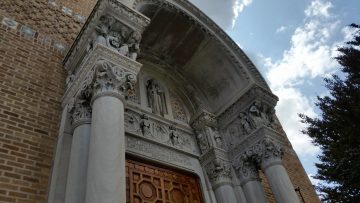
Meyers also cleaned the carvings outside St. Al’s.
“It does take a special breed to do this stuff,” said Joe Brown, one of Meyer’s employees working at St. Al’s. “We climb towers. It’s hard to train somebody to do this.”
Brown said Meyers sets an example.
“He’s been way up where you can’t see, ducking airplanes,” Brown said.
Another employee, Andrew Carnahan, was working on a job at St. Mark’s Lutheran Church in Bowling Green.
“He’s a phenomenal mentor. He knows all the tricks,” Carnahan said.
“There’s really no difference between a 2-story house and being hundreds of fee up – it’s just a better view,” Carnahan said.
Though his skills are well-known, Meyers does not take needless chances for himself or his crew. “There are lot of irresponsible people who want to do it,” Meyers said.
Meyers admits that he has been very protective of his children when it comes to climbing.
“I never let my kids climb trees,” he said.
However, both his son and daughter has worked with him, and climb mountains on their own.
Meyers now spends his winters at his home in Maui – where he can work year-round. There he helps maintain systems on top of towers for power companies and information technology businesses.
But much of his heart is back here on the mainland.
“I feel a closeness with the community here,” Meyers said about Bowling Green. “It’s the university. It’s the people. It’s the buildings.”
He swears this will be his last year as a full-time steeplejack. Of course, there are always steeples and towers that need to be climbed and fixed.

